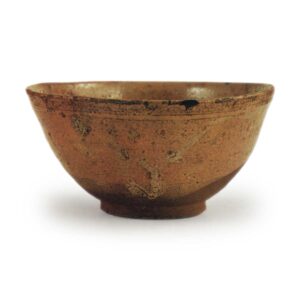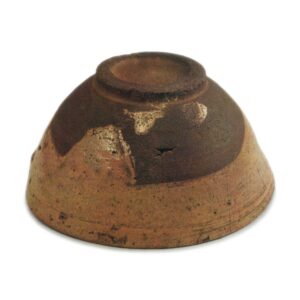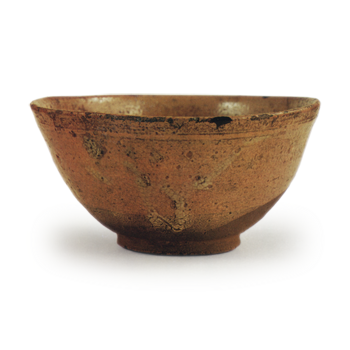

Height: 7.8-8.1cm
Diameter: 15.2-16.0cm
Outer diameter of foot ring: 6.5cm
Height of foot ring: 0.7cm
This tea bowl is famous along with Korekan Karatsu, and it is said that it was owned by a doctor called Nakao Korekan, or that it was made to his taste, and so it bears the name Nakao.
It is not known today why the name was divided into Nakao and Korokan, or who gave it that name. Some people value this Nakao Karatsu more highly than Korokan Karatsu because it is fired with a slight oxidation and the whole piece is a soft loquat-colored color. The clay is a rough clay with small grains of sand, and it is hard and well-fired, probably due to the high feldspar content of the clay. There is a small amount of iron, and the unglazed parts are slightly browned and darkened by tea stains.
A transparent glaze is applied inside and out, and there are rough cracks all over. The firing is slightly oxidized, and the overall color is loquat-colored, but there are also parts that have a bluish tinge due to reduction. The firing is slightly sweet, and the glaze has a dull sheen. The lower half of the body is exposed, but there are traces of the glaze on the side of the foot ring, and there are two spots with speckled glaze.
The shape is a wide, flat bowl with a square base, and at first glance it looks very similar to Koan Karatsu ware, but the rim is not as slightly curved as Koan ware, and the mouth is rounded and pinched straight, which is commonly referred to as a “monk’s mouth”. The thick foot is low and large, and has a solid appearance.
The inside is concave, the glaze is thick, and it has a peeling effect, with three cracks.
There are seven or eight small tears around the rim, which have been repaired with black lacquer. There are also five or six thin grooves, but they are not particularly noticeable. It is one of Karatsu’s outstanding tea bowls, with a solid and heavy build. Some people value its loquat-colored skin and plain but solid appearance even more than Korekan, and it is a rare tea bowl in Karatsu.
Like Korai, it was probably made in the late Momoyama or early Edo period at a Karatsu kiln belonging to the Matsuura family, but it is impossible to say which kiln it was.
There is also a tea bowl called Nakao Karatsu in the Nezu Museum. It is a lighter-looking tea bowl with a more bluish hue, a thinner body, and a taller back. I don’t know if there are any other tea bowls called Nakao Karatsu, but it is certain that there are very few surviving examples of the type.
The accompanying items are
an inner box made of paulownia wood, and a slip-on lid with the name “Nakao” written on it
Like Korekan Karatsu, it is said that this tea bowl was passed down in the Konoike family.



